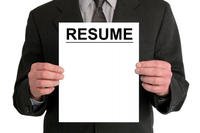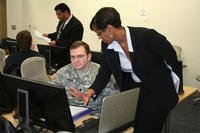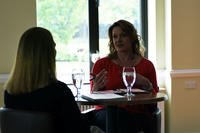"I don't know what's wrong with my resume. I've stared at it too long. But I know it needs help."
Sound familiar? We heard that comment from at least 10 people at the Spouse Experience at Marine Corps Recruit Depot San Diego alone -- pretty much par for the course.
Related: Does your resume pass the 6-second test? Get a FREE assessment.
For Army wife Katy, admitting that her resume needed help was a big step. A two-year job search had netted her nothing, and despite a strong job history and great references, Katy spent her entire time in Georgia unemployed. "It felt inevitable, like this was my destiny. Rejection."
Katy felt pretty hopeless until someone suggested something new. "It wasn't really new," Katy admits. "It's just I haven't done it yet because it seemed like a waste of time."
That suggestion? Maybe it's time to workshop your resume, Katy.
Workshopping your resume is a buzz-wordy term. As a job seeker, workshopping your resume is something you hear about all the time: In job columns, job fairs, maybe even in small-group sessions at your military installation.
"I've spent hours making sure it's a good resume," Katy said. "So I don't want to waste any more time on it. I can use that time for job applications."
Yet with a new PCS in front of them, Katy began to wonder if there was something wrong with her resume. After all, she had put in all those job applications and she got no bites at all.
Katy began to look for advice. "I'm interested in workshopping it, but I don't know what that means."
Workshopping your resume is a really simple process.It means asking yourself a handful of questions each time you ready your resume for a job application, and then going over it with fresh eyes before hitting "send" or "print."
While workshopping your resume is typically done in a group setting, the good news is it is something you can do at home. Here's how.
Step One: Do a Basic Once-Over
You probably keep a copy of your resume saved on your computer for ready access whenever you need it. But when was the last time you bothered to give it a clean read?
"I always refresh my resume when I'm looking for a new job," Katy said. "But I never look at it otherwise."
In the resume world, that's Big Error Number One. You probably think of your resume as a boring list of all the things you have done so far. Consequently, going back to it once a year to see how you can clean it up is not on your to-do list.
"It should be," said Cheryl, a Marine Corps spouse who used to work as a recruiter. "It was a previous life -- kids and the Marine Corps ago. But the lessons I learned stayed with me," she said.
Related: The Military Spouse Employment Manual
"You can always tell the boring resumes from the ones that had effort in them. If your resume is boring and dull, it tells us you are too. It said you don't care about your first impression."
She suggests you set a time once a year -- back-to-school in the fall or spring cleaning time -- to give your resume a fresh read. "If a description is boring, try to liven it up. If you can barely read through it because it's so dull, we won't like it any better."
This is also a great time to catch the typos and copy errors you have made on your resume. "It happens on the best of them," she said. And of course it does -- we spend so much time pouring ourselves into our resumes we stop seeing the errors.
"That's why you need to look at it afresh once a year."
Once you have your resume cleaned up, it is time to start to get it ready for your new job.
Step Two: Tailor It Specifically for the Job
That's right. Now that you have put all that effort into making a good, non-boring, non-listicle of your work, it is time to re-work it already.
Katy, the Army spouse who was getting nowhere with her job hunt, admits that she never once revised a resume specifically for a job.
"I was sending out 100 resumes a week," admits Katy, who is now beginning to see the error of her ways. "I really needed a job. And at that time, I didn't have the time to make them perfect for each job,"
It isn't a surprise that Katy didn't get a job that way. Instead, she got 100 silent rejections. "No one took the time to tell me no," she said.
Part of Katy's problem is that she did not take the time to tell all those employers why she should be their yes. Her resume did not speak to the jobs for which she was applying specifically. It should have.
Cheryl said we should pay attention to the wording of the job description. "In each job description, you'll find several keywords," she explains. "Those are the words -- usually verbs or nouns, like "managing" or "supervisor" -- that they think are important to find in a matching candidate."
If you want to be the matching candidate, those words need to appear in your resume, too.
A job opening for an administrative assistant might ask for experience handling receipts and remittances.
Your resume might include a line about balancing accounting books. Instead of writing something like: "Managed accounting books for X department," consider changing your verbiage to match that of the job description. You could write something like: "Processed all receipts, remittances and budgetary requests for X department, with a budget totaling XYZ dollars."
"The people looking at your resume don't have time to translate your job skills. It's your job to do that for them. So if you have the skills they are asking for, use their language to demonstrate," said Cheryl.
Changing your resume like this for each job might seem like a lot of work, but once your resume is polished and strong, tailoring it should take less than 20 minutes.
"I could have spent 20 minutes on it," Katy admits. "And I will from now on."
Step Three: Keep It Scannable
This is a secret most career counseling offices fail to relay to their school's graduates as they start developing their own resumes. You should know that many job applications are first scanned by a computer before they even make their way to a real human being.
That means that if a computer is going to look at your resume first, you need to make sure that you and the computer are speaking the same language.
Scanning resumes is standard operating procedure for big organizations, which means that if you are applying to a big bureaucracy -- particularly a job in the government or on base, your resume needs to be scanner-friendly.
A few tricks to increase scannability:
- Use Times New Roman throughout your resume. Some programs are better at reading less common fonts, but you do not want to have your resume thrown out because you wrote it in Arial instead of Times.
- Do not increase the size of your font in your section headings.
- Avoid bullet points and any visuals.
- For a resume you know will be scanned, consider creating a "keywords" section just below your name that is formatted the same as your education and experience sections. In this section, list the keywords addressed in the job description, e.g., leadership skills, team building, team management, accounting skills.
Scanner-friendly resumes are not the best looking, so if you aren't sure if your resume is going to be read by a scanner first, consider calling human resources and asking. That way you know how to prepare it: for human eyes, or for a computer.
Step Four: Brand It
If you are not focused on creating a resume that will ace the scanner's test, you need to focus on the overall design of your materials. In other words, you need to think about branding.
On a resume level, branding is about making sure your cover letter, resume and references page (along with any other applicable materials) all have the same layout, design and feel.
"They should look like they go together," said Army wife Erica. "I always make sure that the font is the same, the header is the same, and the presentation is the same. If for any reason any of my pages get lost in the pile, I want them to be able to pull it out and say, ‘Oh, that's Erica's!' just by looking at it."
A smart way to brand your materials is to print your name and contact information at the top of each page in the exact same format. Consider using a thin line (you can find those in Word under Insert > Picture > Horizontal Line) to separate your name and contact information from the rest of the page. It will act as a header across all of your submitted materials, and it will show a degree of polish many resumes lack.
"You would be surprised how many people had two page resumes that didn't have name or contact information on both pages," said Cheryl. "Or cover letters that didn't match the font on their resume. These are little mistakes, but when there are five qualified candidates, that can be enough to make the difference."
Step Five: A Final Once Over
It should go without saying: Once you have workshopped your resume for a specific job application, proof it to make sure there are no new errors. Adding in job-appropriate keywords, formatting it for scanning, or making it pretty for a human to interact with can lead to simple, easy-to-fix mistakes.
"That's my biggest takeaway," Katy said. "All this time, there was a semicolon on my resume I didn't even know I had. I never saw it."
Make sure you give your resume a fresh read before you submit it, or ask a friend or your spouse to give it a once-over. "People will always catch things you miss," Cheryl reminds us. "Better you than the recruiter."
-- If you need help workshopping your resume, let us know! We want to know about the problems you're facing so we can help other spouses just like you who are in the same position.
Related: For the latest veteran jobs postings around the country, visit the Military.com Job Search section.
Looking for more job tips?
Sign up for a free Military.com membership to have military news, updates and job resources delivered directly to your inbox.























